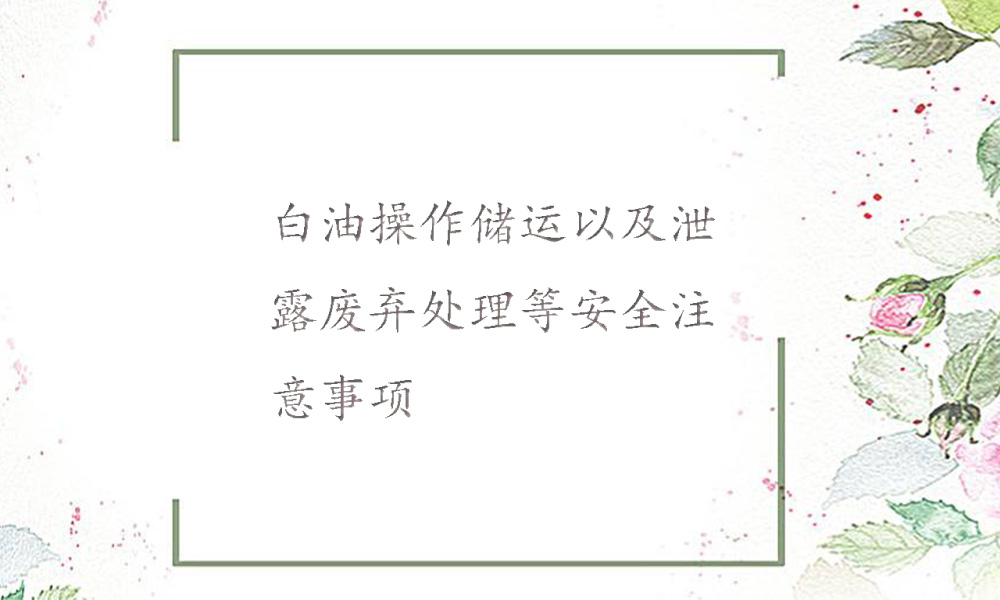
White oil is also known as liquid paraffin and white mineral oil, suitable for rubber and plastics And resin industry, food industry, pharmaceutical industry, pesticide industry, daily chemical industry, etc. Because it has a wide range of uses, you should know more about the characteristics and correct operation of white oil. The following white oil suppliers will take you to understand the safety precautions for the operation, storage, transportation and leakage disposal of white oil:
1. Danger:
1. Characteristics: relatively stable to light, heat, and acid, and does not react chemically under neutral conditions. Soluble in hydrocarbons, it will slowly oxidize into peroxide when exposed to heat and light for a long time.
2. Health hazards: It is less toxic, but long-term contact with the skin will cause erythema or chronic eczema.
Mineral oil is not absorbed or digested in the human intestine. Can hinderAbsorption of water It is used medically as a lubricating laxative to treat constipation in the elderly or children. . Ingesting large amounts can causeSoft stool, diarrhea; long-term intake can cause digestion Tract obstruction affects the absorption of fat-soluble vitamins A, D, K, calcium, phosphorus, etc. It is extremely harmful to the human body. It will take out all the fat-soluble vitamins from the human body, making them unable to be absorbed by the human body. Eating mineral oil will lead to a serious lack of vitamins A, D, E, and K in the human body, resulting in a series of pathologies.
2. Fire-fighting measures:
White oil is flammable
Fire extinguishing : mist water, foam, dry powder, carbon dioxide, sand.
Fire fighting precautions: When entering a fire scene in a narrow space, you should wear breathing apparatus. Oil tanks and building facilities near the fire scene should be sprayed with water for cooling.
3. Operation, processing and storage:
Usage: handle with care, and wear gloves.
Save:
1. The container must be covered and sealed to reduce evaporation;
2. Ventilation;
3. Avoid sunlight and place it in a low place;
4. Keep away from fire sources;
5. Do not directly contact the skin with white mineral oil, and prevent the liquid from pouring out.
IV. Emergency response to leakage:
1. Quickly evacuate personnel in the leaked contaminated area to a safe area, isolate them, strictly restrict access, and cut off the source of fire;
2. Small leakage: use sand or other non-combustible materials to absorb or absorb;
3. Large leakage: Construct dikes or dig pits to contain them, use pumps to transfer them to tankers or special collectors, and recycle or transport them to Waste disposal sites.
5. Disposal:
1. Unused products/empty containers: Old barrels that are still usable can be returned to the supplier, or the old barrels can be refurbished Please do not remove the label on the old barrel; do not cut or burn the old barrel; do not pressurize the old barrel; when the old barrel is reused, the original label must be removed or cleared first.
2. Disposal: Do not throw away empty containers or unused products by yourself.
Six. Transportation Note:
Check whether the packaging container is complete and sealed before transportation, and ensure that the container does not leak or be damaged during transportation , it is strictly prohibited to mix and transport with oxidants, acids, food chemicals, etc.
Neue’, ‘PingFang SC’, ‘Hiragino Sans GB’, ‘Microsoft YaHei’, ‘\\5FAEsoft Yahei’, SimSun, Arial, sans-serif; font-size: 16px; line-height: 24px; white- space: normal;”> 2. Small leakage: use sand or other non-combustible materials to absorb or absorb;
3. Large leakage: Construct dikes or dig pits to contain them, and use pumps to transfer them to tankers or special collectors. , recycled or transported to waste disposal sites.
5. Disposal:
1. Unused products/empty containers: Old buckets that are still usable can be returned Supplier, or hand it over to the old barrel refurbishment factory, but please do not remove the label on the old barrel; do not cut or burn the old barrel; do not pressurize the old barrel; when the old barrel is reused, it must be removed or cleaned first Original label.
2. Disposal: Do not throw away empty containers or unused products by yourself.
Six. Transportation Note:
Check whether the packaging container is complete and sealed before transportation, and ensure that the container does not leak or be damaged during transportation , it is strictly prohibited to mix and transport with oxidants, acids, food chemicals, etc. <br/

 微信扫一扫打赏
微信扫一扫打赏

